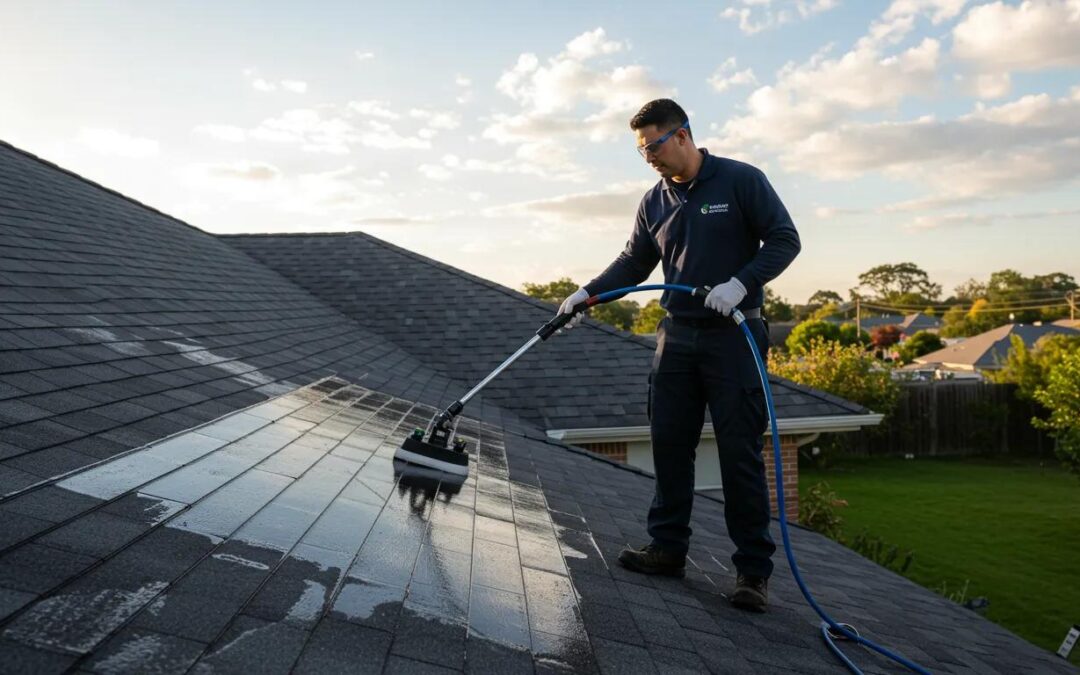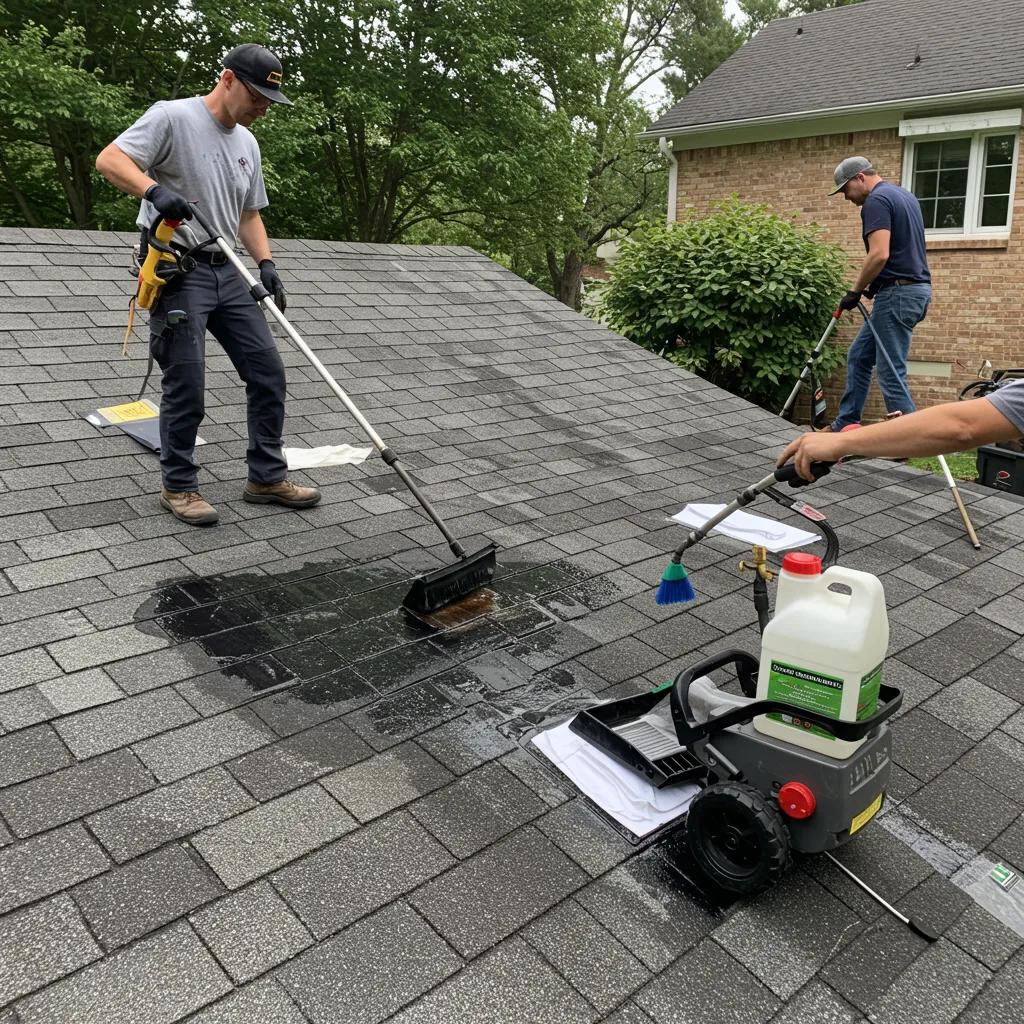Eco-Friendly Soft Wash: Revive Your Roof's Longevity & Curb Appeal
What Is Soft Wash Roof Cleaning and How Is It Eco-Friendly?
How Does Soft Washing Differ from Pressure Washing?
What Biodegradable Cleaning Solutions Are Used in Soft Washing?
Algae-Prone Building Materials: Sustainable Facade Design and Biocide Alternatives
The effect of in-situ generated protons on the development of algal colonization of façade coatings. The effect of in-situ generated protons on the development of algal rather than fighting symptoms of algal colonization with organic biocides and Investigation of Building Materials Containing Algae-Prone Properties: Perspectives for Sustainable Façade Design, 2024
Why Is Soft Washing Safe for Roofs and Surrounding Plants?
Which Common Roof Problems Can Eco-Friendly Soft Washing Solve?
| Issue | Characteristic | Typical signs |
|---|---|---|
| Algae | Pigmented cyanobacteria (Gloeocapsa magma) | Black streaks or gray staining, often downhill from roof ridges |
| Moss | Moisture-loving bryophytes | Raised, green cushions or tufts that hold moisture against shingles |
| Lichen | Symbiotic crusty growth | Scaly, crust-like patches that are often pale or greenish |
| Mold & Mildew | Fungal colonization | Dark spots, musty odors near gutters, and soft-textured surface growth |
How Does Soft Washing Remove Algae and Black Streaks Safely?
What Are Effective Eco-Friendly Solutions for Moss and Lichen Control?
How Does Soft Washing Eradicate Mold and Mildew for Healthier Homes?
Hydrogen Peroxide Emissions from Household Surface Cleaning and Indoor Air Quality
High levels of reactive chemicals may be emitted to the indoor air during household surface cleaning, leading to poorer air quality and potential health hazards. Hydrogen peroxide (H2O2)-based cleaners have gained popularity in recent years, especially in times of COVID-19. Still, little is known regarding the effects of H2O2cleaning on indoor air composition. In this work we monitored time-resolved H2O2concentrations during a cleaning campaign in an occupied single-family residence using a cavity ring-down spectroscopy (CRDS) H2O2analyzer. During the cleaning experiments, we investigated how unconstrained (i.e., “real-life”) surface cleaning with a hydrogen peroxide solution influenced the indoo Hydrogen peroxide emissions from surface cleaning in a single-family residence, PAF Souza, 2023
Why Choose Professional Residential Eco-Friendly Roof Cleaning Services?
| Role | Attribute | Value |
|---|---|---|
| Technician | Training | Certified/experienced operators using calibrated low-pressure systems |
| Equipment | Type | Low-pressure application rigs, containment accessories, safety gear |
| Warranty | Duration | Example professional coverage: one-year clean roof warranty |
| Homeowner (DIY) | Training | Limited; higher risk of improper application and roof damage |
What Is the Step-by-Step Residential Soft Wash Roof Cleaning Process?
How Do Biodegradable Cleaners Protect Your Roof and Environment?
What Are the Typical Costs and Warranty Options for Residential Roof Cleaning?
How Does Eco-Friendly Roof Cleaning Benefit Commercial Properties?
Why Is Regular Soft Wash Cleaning Important for Commercial Roof Maintenance?
What Types of Commercial Facilities Can Benefit from Soft Wash Roof Cleaning?
How Is the Commercial Soft Washing Process Tailored for Different Roof Types?
How Often Should You Schedule Eco-Friendly Roof Cleaning for Best Results?
What Factors Influence Roof Cleaning Frequency in Baton Rouge’s Climate?
How Long Do Soft Wash Cleaning Results Typically Last?
Can Homeowners Safely Perform DIY Eco-Friendly Roof Cleaning?
What Are the Environmental and Health Benefits of Choosing Eco-Friendly Roof Cleaning?
How Do Biodegradable Cleaners Reduce Environmental Impact?
Why Is Soft Washing Better for Pets, Plants, and Local Ecosystems?
How Does Eco-Friendly Roof Cleaning Extend Roof Lifespan and Curb Appeal?
What Are Common Questions About Eco-Friendly Roof Cleaning?
What Is the Most Eco-Friendly Way to Clean a Roof?
Is Soft Washing Safe for All Roof Types Like Asphalt, Tile, and Metal?
What Chemicals Are Used in Biodegradable Roof Cleaners?
How Long Does a Soft Wash Roof Cleaning Take?
What Warranty and Satisfaction Guarantees Are Offered?
- Inspection: Schedule a professional assessment to determine roof type and biological load.
- Protection: Shield landscaping and non-target surfaces before application.
- Application: Use calibrated low-pressure equipment with biodegradable cleaners.


